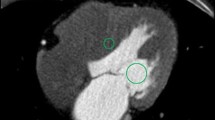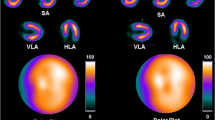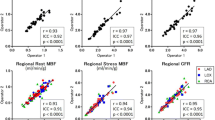Abstract
Left ventricular (LV) myocardial contrast enhancement can be recorded using 320 multi detector computed tomography (MDCT). We aimed to (1) assess patterns of regional myocardial perfusion at rest and compare them with NH3 positron emission tomography (PET) (2) and to assess the effect of intravenous adenosine infusion on regional myocardial perfusion. To evaluate myocardial perfusion patterns at rest, we scanned 14 healthy subjects with PET and 14 age and gender matched subjects with 320 MDCT. To evaluate the effect of adenosine stress on relative perfusion patterns 14 subjects with near-normal epicardial coronary arteries were studied at rest and during adenosine stress. Relative perfusion was assessed as attenuation density (AD) in 16 segments of the LV, and each segment was divided into 3 layers: endo-, mid- and epi-cardial. During rest the relative AD by MDCT was lower in the lateral wall compared with the remainder of the LV (P < 0.002). A similar pattern was found by PET-imaging. LV endocardial AD was higher than mid- and epicardial AD (P < 0.05). At rest the endocardial/epicardial ratio in the septum was 0.99 compared with 1.23 in non-septal segments (P < 0.001). During adenosine infusion transmural AD increased due to significant increases in the mid- and epicardium and the endocardial/epicardial ratio decreased by 18% in non-septal segments (from 1.23 to 1.05 P < 0.001). Relative perfusion at rest is lower in the lateral wall of the LV with both PET and MDCT compared to the remainder of the myocardium. During adenosine stress endocardial/epicardial ratio decrease significantly.





Similar content being viewed by others
References
George RT, Jerosch-Herold M, Silva C, Kitagawa K, Bluemke DA, Lima JA, Lardo AC (2007) Quantification of myocardial perfusion using dynamic 64-detector computed tomography. Invest Radiol 42:815–822
Rumberger JA, Feiring AJ, Lipton MJ, Higgins CB, Ell SR, Marcus ML (1987) Use of ultrafast computed tomography to quantitate regional myocardial perfusion: a preliminary report. J Am Coll Cardiol 9:59–69
Wolfkiel CJ, Ferguson JL, Chomka EV, Law WR, Labin IN, Tenzer ML, Booker M, Brundage BH (1987) Measurement of myocardial blood flow by ultrafast computed tomography. Circulation 76:1262–1273
Blankstein R, Shturman LD, Rogers IS, Rocha-Filho JA, Okada DR, Sarwar A, Soni AV, Bezerra H, Ghoshhajra BB, Petranovic M, Loureiro R, Feuchtner G, Gewirtz H, Hoffmann U, Mamuya WS, Brady TJ, Cury RC (2009) Adenosine-induced stress myocardial perfusion imaging using dual-source cardiac computed tomography. J Am Coll Cardiol 54:1072–1084
George RT, Rbab-Zadeh A, Miller JM, Kitagawa K, Chang HJ, Bluemke DA, Becker L, Yousuf O, Texter J, Lardo AC, Lima JA (2009) Adenosine stress 64- and 256-row detector computed tomography angiography and perfusion imaging: a pilot study evaluating the transmural extent of perfusion abnormalities to predict atherosclerosis causing myocardial ischemia. Circ Cardiovasc Imaging 2:174–182
Okada DR, Ghoshhajra BB, Blankstein R, Rocha-Filho JA, Shturman LD, Rogers IS, Bezerra HG, Sarwar A, Gewirtz H, Hoffmann U, Mamuya WS, Brady TJ, Cury RC (2010) Direct comparison of rest and adenosine stress myocardial perfusion CT with rest and stress SPECT. J Nucl Cardiol 17:27–37
Rocha-Filho JA, Blankstein R, Shturman LD, Bezerra HG, Okada DR, Rogers IS, Ghoshhajra B, Hoffmann U, Feuchtner G, Mamuya WS, Brady TJ, Cury RC (2010) Incremental value of adenosine-induced stress myocardial perfusion imaging with dual-source CT at cardiac CT angiography. Radiology 254:410–419
Rodriguez-Granillo GA, Rosales MA, Degrossi E, Rodriguez AE (2010) Signal density of left ventricular myocardial segments and impact of beam hardening artifact: implications for myocardial perfusion assessment by multidetector CT coronary angiography. Int J Cardiovasc Imaging 26:345–354
Kitagawa K, George RT, rbab-Zadeh A, Lima JA, Lardo AC (2010) Characterization and correction of beam-hardening artifacts during dynamic volume CT assessment of myocardial perfusion. Radiology 256:111–118
George RT, Silva C, Cordeiro MA, DiPaula A, Thompson DR, McCarthy WF, Ichihara T, Lima JA, Lardo AC (2006) Multidetector computed tomography myocardial perfusion imaging during adenosine stress. J Am Coll Cardiol 48:153–160
Porenta G, Kuhle W, Czernin J, Ratib O, Brunken RC, Phelps ME, Schelbert HR (1992) Semiquantitative assessment of myocardial blood flow and viability using polar map displays of cardiac PET images. J Nucl Med 33:1628–1636
Nieman K, Shapiro MD, Ferencik M, Nomura CH, Abbara S, Hoffmann U, Gold HK, Jang IK, Brady TJ, Cury RC (2008) Reperfused myocardial infarction: contrast-enhanced 64-Section CT in comparison to MR imaging. Radiology 247:49–56
de Jong RM, Blanksma PK, Willemsen AT, Anthonio RL, Meeder JG, Pruim J, Vaalburg W, Lie KI (1995) Posterolateral defect of the normal human heart investigated with nitrogen-13-ammonia and dynamic PET. J Nucl Med 36:581–585
Kofoed KF, Hove JD, Freiberg J, Host U, Hesse B, Kelbaek H (2001) Relationship between regional 18F-fluorodeoxyglucose and 13N ammonia uptake in normal myocardium assessed by positron emission tomography: patterns of mismatch and effects of aging. Int J Cardiovasc Imaging 17:361–370
Loghin C, Sdringola S, Gould KL (2004) Common artifacts in PET myocardial perfusion images due to attenuation-emission misregistration: clinical significance, causes, and solutions. J Nucl Med 45:1029–1039
Bastarrika G, Ramos-Duran L, Rosenblum MA, Kang DK, Rowe GW, Schoepf UJ (2010) Adenosine-stress dynamic myocardial CT perfusion imaging: initial clinical experience. Invest Radiol 45:306–313
Duncker DJ, Bache RJ (2008) Regulation of coronary blood flow during exercise. Physiol Rev 88:1009–1086
Radjenovic A, Biglands JD, Larghat A, Ridgway JP, Ball SG, Greenwood JP, Jerosch-Herold M, Plein S (2010) Estimates of systolic and diastolic myocardial blood flow by dynamic contrast-enhanced MRI. Magn Reson Med 64:1696–1703
James TN, Burge GE (1958) Blood supply of the human interventricular septum. Circulation 17:391–396
Armstrong RB, Essen-Gustavsson B, Hoppeler H, Jones JH, Kayar SR, Laughlin MH, Lindholm A, Longworth KE, Taylor CR, Weibel ER (1992) O2 delivery at VO2 max and oxidative capacity in muscles of standardbred horses. J Appl Physiol 73:2274–2282
Duncker DJ, Ishibashi Y, Bache RJ (1998) Effect of treadmill exercise on transmural distribution of blood flow in hypertrophied left ventricle. Am J Physiol 275:H1274–H1282
Bache RJ, Cobb FR (1977) Effect of maximal coronary vasodilation on transmural myocardial perfusion during tachycardia in the awake dog. Circ Res 41:648–653
Acknowledgments
Research radiographer Tina Bock-Pedersen and research nurse Kristina Molge are thanked for excellent technical assistance.
Conflict of interest
Dr Kofoed has received lecture fees from Toshiba Medical Systems Corporation. Dr. George has received research support from Astellas Pharma US, Inc. and Toshiba Medical Systems Corporation. Dr. George is a consultant for ICON Medical Imaging. The terms of these arrangements are managed by Johns Hopkins University in accordance with its conflict of interest policies.
Author information
Authors and Affiliations
Corresponding author
Rights and permissions
About this article
Cite this article
Kühl, J.T., Linde, J.J., Fuchs, A. et al. Patterns of myocardial perfusion in humans evaluated with contrast-enhanced 320 multidetector computed tomography. Int J Cardiovasc Imaging 28, 1739–1747 (2012). https://doi.org/10.1007/s10554-011-9986-z
Received:
Accepted:
Published:
Issue Date:
DOI: https://doi.org/10.1007/s10554-011-9986-z




